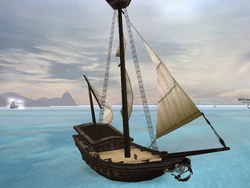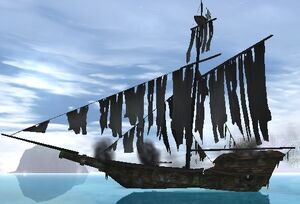
|
"Please, I need your help. Come on!" This article is in need of referencing per sourcing guidelines. This article needs appropriate citations. Help us improve this article by referencing valid resource material. Remove this notice when finished. |

- "I'd been studyin' him through me spyglass, and I had me suspicions. The ship was a sloop, Bermuda rigged, common vessel, especially in these parts."
- ―Hector Barbossa to pirates at Shipwreck Cove
A sloop was a fore-and-aft rigged ship type, normally with only one mast. Larger square rigged sloops with two masts were known as brigs or brig-sloops, while sloop-of-war was a name given to square rigged three masted ships with under 24 cannons. A war sloop was a name given to a two masted fore-and-aft rigged sloop.
History

- "There! It's just like sailing a Sloop, ye never forget how..."
- ―Cursed Captain
The sloop, armed with five to ten cannons, was the most popular ship in the Caribbean Sea because of its speed and maneuverability. Its shallow draft enabled the pirate navigator to sail close to reefs and shoals and through narrow channels. He could out-maneuver a man-of-war in shallow water or run down a beamy merchant ship on the open sea. Attacking a moored ship at night was a profitable pirate practice: longboats propelled by oars carried the buccaneers silently toward their prey. From these boats, the cutlass-swinging rogues swarmed over the gunwales, capturing the sleeping crew and the ship's cargo. A common offensive employed by pirates in the Caribbean during the eighteenth century was to ambush a sloop by using a fleet or armada of longboats.[1]
The Cobra, a schooner owned by Captain Hector Barbossa, was attacked by the Koldunya, a sloop captained by Boris "Borya" Palachnik, the Pirate Lord of the Caspian Sea.[2][3] Edward Teach's career as a pirate began when he fell in with Ben Hornigold, quite a pirate in his own right, who gave young Teach command of a sloop.[4] Calico Jack Rackham was a small-time pirate who commanded a single, small sloop rather than an armada full of buccaneers.[5] Sloops were often used by pirates during the War of Jolly Roger.[6] By the time Lord Cutler Beckett arrived to Port Royal, a British Royal Navy sloop, the Perseverance, was anchored in the harbor.[7]
Rigging
Single masted sloops were usually gaff or fore-and-aft rigged, meaning that they had a gaff sail stretching from the mast to the back, and one or two jib sails or genoa sails. This rig allows a sloop extreme maneuverability, and allows the craft to sail very well at beam reach or beside the wind, meaning that the wind is coming directly from starboard or port side of the vessel. Square topsails or other sails are optional for better running (sailing with the wind coming from your back). War sloops are very similar, but with a second mast behind the main carrying a lateen sail.[citation needed]
Sloops-of-War are completely square rigged, with one gaff-sail and a couple of jibs besides. [citation needed]
Notable sloops

- Jack Sparrow's sloop[citation needed]
- Albion[citation needed]
- Adventure[citation needed]
- Barracuda[6]
- Bloodhound[6]
- Dying Gull[citation needed]
- Grim Reaper[6]
- Corsair[6]
- Ferret[6]
- French Blood Scourge[6]
- French Cerberus[6]
- French Shadow Crow[6]
- Gretchen[6]
- Greyhound[6]
- Kingfisher[6]
- Koldunya[2]
- Perseverance[7][8]
- Predator[6]
- Sea Viper[6]
- Spanish Blood Scourge[6]
- Spanish Cerberus[6]
- Spanish Shadow Crow[6]
Behind the scenes
Sloops were first identified by name in the souvenir book for Walt Disney's Pirates of the Caribbean.[1] Their first in-universe appearance in the 2003 video game Pirates of the Caribbean.[citation needed]
The Providence, a 110-foot topsail fighting sloop, a replica of Rhode Island's first naval vessel, USS Providence, appeared in the back-to-back production of Dead Man's Chest and At World's End. In Dead Man's Chest, the Providence was seen as the Perseverance.[7][8]
Two of the pirate ships in Climb Aboard If You Dare!: Stories From The Pirates of the Caribbean, the Buzzard and Smilin' Jack's ship, are called sloops several times. However, the illustrations in the book show both ships as large, three-masted vessels.[9]
In Pirates of the Caribbean Online, the sloop is one of the four ship classes. A "war sloop" is a name given to a two masted fore-and-aft rigged sloop.[6]
Appearances
- Climb Aboard If You Dare!: Stories From The Pirates of the Caribbean
- Pirates of the Caribbean (2003 video game) (First appearance)
- Pirates of the Caribbean: Call of the Kraken
- Jack Sparrow: The Age of Bronze
- The Price of Freedom
- Pirates of the Caribbean: The Curse of the Black Pearl (video game)
- Pirates of the Caribbean: Isles of War
- Smoke on the Water
- Pirates of the Caribbean Online
- Pirates of the Caribbean: Dead Man's Chest
- Pirates of the Caribbean: At World's End
- The Brightest Star in the North: The Adventures of Carina Smyth
- Pirates of the Caribbean: Dead Men Tell No Tales
- Sea of Thieves: A Pirate's Life (Non-canonical appearance)
Sources
- Walt Disney's Pirates of the Caribbean: The Story of the Robust Adventure in Disneyland and Walt Disney World (First identified as sloop)
External links
Sloop on Wikipedia
Sloop-of-war on Wikipedia
Notes and references
- ↑ 1.0 1.1 Walt Disney's Pirates of the Caribbean: The Story of the Robust Adventure in Disneyland and Walt Disney World, p. 8
- ↑ 2.0 2.1 The Price of Freedom, Chapter Two: Lady Esmeralda
- ↑ The Price of Freedom, Chapter Eight: The Devil in the Deep Blue Sea
- ↑ Walt Disney's Pirates of the Caribbean: The Story of the Robust Adventure in Disneyland and Walt Disney World, p. 13
- ↑ The Captain Jack Sparrow Handbook, p. 33
- ↑ 6.00 6.01 6.02 6.03 6.04 6.05 6.06 6.07 6.08 6.09 6.10 6.11 6.12 6.13 6.14 6.15 6.16 6.17 Pirates of the Caribbean Online
- ↑ 7.0 7.1 7.2 Pirates of the Caribbean: Dead Man's Chest
- ↑ 8.0 8.1 POTC2 Presskit, p. 37
- ↑ Climb Aboard If You Dare!: Stories From The Pirates of the Caribbean